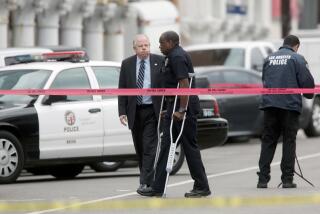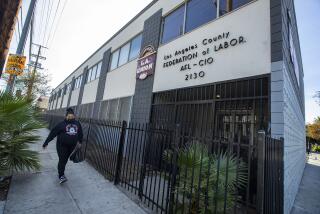City Says D.A. Botched Brookins Case : Justice: The statute of limitations expired after two years of inaction by prosecutors, a city attorney says. The district attorney’s office says L.A. was slow in handling the case.
The district attorney’s office erred when it dropped a criminal investigation of Bishop H.H. Brookins on grounds that the three-year statute of limitations for fraud and embezzlement had elapsed, city officials said Thursday.
Deputy City Atty. Frank Orozco said the statute did not expire until 1989, well after allegations that Brookins disguised his ownership of an office complex to obtain a $336,000 government renovation loan were referred to the district attorney’s office.
“They sat on it for two years,” Orozco said.
Prosecutors maintain that the statute took effect in 1982 when city staffers should have known that the property was not owned by an African Methodist Episcopal Church corporation as purported by Brookins. Thus the statute expired in 1985--two years before the city referred the Brookins case to the district attorney’s office, said Deputy Dist. Atty. Stephen Licker.
In any case, both sides agree the statute has now elapsed and that no charges can be filed against Brookins.
The Times reported on Feb. 3 that Brookins, a respected leader in the AME Church and longtime political mentor to Mayor Tom Bradley, obtained the federally funded loan through the city to refurbish the office complex, located in Southwest Los Angeles on Crenshaw Boulevard. City officials said they would not have approved the renovation loan if they had known that Brookins, not the AME Church, owned the building.
A city investigation released Wednesday found that the AME Church corporation listed as the property owner “was neither a nonprofit entity nor an entity of the AME Church as it was purported to be at the time (the) contract was executed by H.H. Brookins. The investigation ultimately determined (the) facility was actually owned by Brookins at the time the contract was obtained through the name of (the church).”
The report concluded that the city is owed $48,259 in rent paid to Brookins because the bishop violated conflict-of-interest provisions in city contracts for the last eight years. The conflict stemmed from Brookins serving as the landlord and head of South Los Angeles Development Corp., a community education program that received rent payments from the city since 1981.
Citing the “blatant” nature of the violations, city officials said they will try to recover interest on the $48,259 owed.
The investigation by the city’s Community Development Department (CDD) was criticized Wednesday as “disgraceful” and “close to slanderous” by Brookins’ attorney, J. Stanley Standers.
Sanders said the conclusion that the AME Church corporation does not exist because it did not file California incorporation papers is “an insult and offensive to 3.5 million African-Americans who are members of that church.”
Beginning in 1987, the district attorney’s office investigated allegations that Brookins concealed the true ownership of the building to receive the government loan and used $26,000 of the proceeds to pay off “personal obligations,” according to investigative reports of the district attorney’s office.
The district attorney’s investigation concluded in July, 1989, that “there was no misrepresentation, intentional or otherwise, when the loan was granted in 1982 and even assuming some misrepresentation or deception, the facts were fully known by the CDD in 1982 and the three-year statute of limitations would bar pursuing any criminal action,” according to the investigative report.
Allen Field, head of the district attorney’s major fraud division, said that because the investigation was incomplete at the time the report was written, it should have said that “no evidence of misrepresentation” was discovered by investigators.
Field said he stopped the investigation in mid-1989 when he learned of the statute of limitations problem.
Asked how important the statute problem was in pursuing the case, Field said, “It’s as big an impediment as can possibly exist.” He said if it weren’t for the statute problem, “I would have asked for more investigation.”
But the district attorney’s office failed to mention the statute of limitations problem to city officials last year when prosecutors dropped the Brookins case, Orozco said.
“It was just somewhat crazy to us to see that in the newspaper for the first time,” said Orozco, referring to a recent Times article. “They have never given us an explanation. They had no report. They had no definite reasoning why they weren’t doing anything, other than to say there was insufficient evidence.”
Deputy Dist. Atty. Licker reiterated in an interview this week that city officials should have had knowledge in 1982 that something was amiss and the renovation funds for the Brookins’ building were going to a non-existent corporation. “They should have known,” he said.
But city officials did not learn that Brookins owned the building until years later, said George C. Hughley, chief of the CDD special investigations unit who conducted the city probe.
“You couldn’t have known in 1982 that Brookins owned the building and fraudulently applied for the loan,” Hughley said. “That proof didn’t come out until later on up the road.”
Orozco said the statute starts when a law enforcement official or investigator hears of a criminal allegation, not when a city staff member is informed.
“You can’t expect a lower-level staff person to conclude, ‘Here’s a crime so the clock starts ticking,’ ” Orozco said. “Here you have an offense where maybe someone at a lower level knew at a very early stage of the circumstances, but it never really filtered up to a higher level.”
Times staff writers Rich Connell and Tracy Wood contributed to this article.
More to Read
Sign up for Essential California
The most important California stories and recommendations in your inbox every morning.
You may occasionally receive promotional content from the Los Angeles Times.









